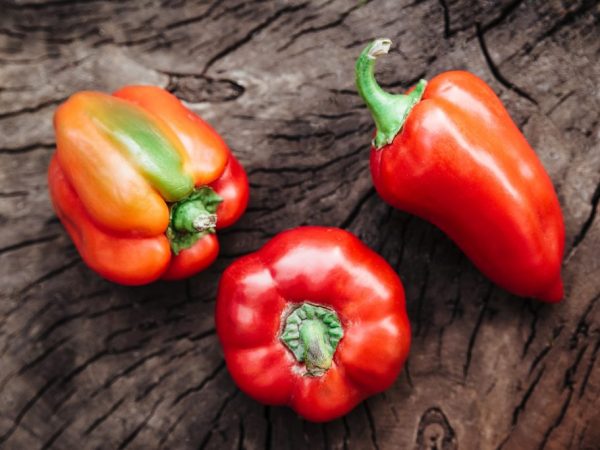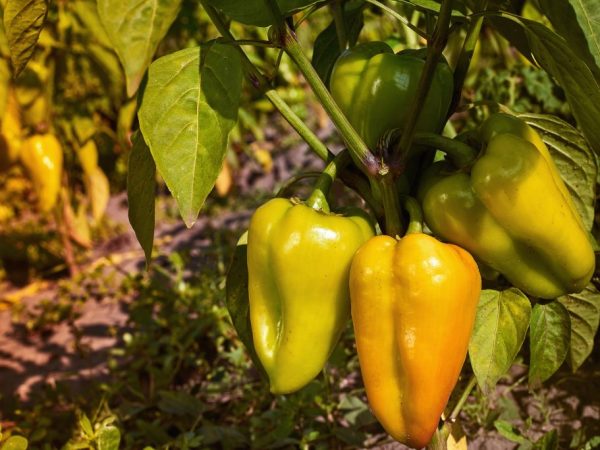Characteristics of Ivanhoe pepper
Pepper Aivengo has a pleasant taste and decent yield indicators, therefore it is popular among gardeners.

Pepper Ivanhoe
Characteristics of the variety
Ivanhoe sweet pepper is the result of African selection. It was withdrawn at the end of the twentieth century, and in 1998 - entered into the State Register of the Russian Federation.
Suitable for growing in greenhouse conditions in all regions of the country. It can only be grown outdoors in the southern regions.
From 1 hectare, farmers collect about 80 centners of commercial quality products.
Description of the bush
The bushes are not sprawling, have an average characteristic of leafiness. The height of the bush is 60-70 cm. Dark green leaves are medium in size, on their surface you can see small wrinkles.
Description of the fetus
This sweet vegetable is believed to be an early crop. The fruits begin to ripen within 100 days after the first shoots appear. The biological maturity of the fruit is observed after 110 days.
According to the description, the fruits of the Ivanhoe pepper have a number of characteristics:
- conical shape;
- smooth surface of the peel;
- average weight - 130 g;
- walls 9 mm thick;
- at technical maturity, the color of the fruit is yellow, when fully ripe, the fruit is red.
The taste is rich, sweet.
Ivanhoe peppers are characterized by a large number of useful trace elements in their composition. They contain vitamins of group C and B, as well as amino acids that have a positive effect on human health. The fruits are suitable for fresh consumption or for making salads. They can be used to prepare various kinds of preservation: adjika, pasta, salads, or preserve as a whole.
Planting and growing
Before proceeding with planting, you should select only high-quality planting material. To do this, the purchased seeds are placed in water for 2 hours. The ones that have emerged are thrown away, and the rest are dipped for 20 minutes in a solution of manganese and a growth stimulant. This disinfects the planting material and accelerates growth. After that, the seeds are taken out and spread on a gauze cloth. In this position, they are dried.

The bush has good fertility.
Now you can start planting seeds. It is better to do this at the end of February, so that the seedlings are formed by summer. Light loose soil is taken into the container and filled by 2/3. The seeds are planted to a depth of 1.5 cm at a distance of 5 cm from each other. After that, the containers are covered with plastic wrap and placed in a dark place with a temperature of 25 ° C until shoots appear.
Disembarkation to a permanent place
As soon as the first shoots have appeared, the seedlings are moved to the windowsill. After the appearance of 2 leaves, it is transplanted to a permanent place. The ideal time for transplanting: in the southern regions - mid-May, in others - early June.
Before transplanting the seedlings to a permanent place, the soil is carefully prepared (all weeds are removed, loosened and organic matter is introduced in the form of peat). The landing pattern is simple.Since the bushes of this sweet variety are not spreading, they keep a distance of 30 cm between the holes.The distance between the rows should be 50 cm.The planting depth of seedlings is 2-3 cm.
Care
It is necessary to remember about regular feeding. Fertilizers are an important step in the care of bell peppers.
- The first feeding should be carried out 2 weeks after transplanting to a permanent place. For these purposes, nitrogen substances should be used, which will help accelerate the growth of the bush.
- The second feeding is carried out during the formation of the ovaries. For this case, it is advisable to use potassium compounds, which will allow the ovaries to develop better.
- At the time of fruiting, a third feeding is carried out using phosphorus, which helps to enhance the taste of the fruit.
Watering is carried out regularly at intervals of 3-4 days. The Ivanhoe variety does not tolerate dry soil and may die. Watering should be carried out in the morning in order to preserve moisture in the soil, because under the influence of sunlight, all moisture evaporates, which will lead to deformation of the root system.
Do not forget about the garter and supports, because a large number of fruits will break the bush. If necessary, all weeds are removed, the soil is loosened so that the root system receives the right amount of air.
Diseases and pests
The Aivengo pepper variety has a stable immune system, therefore, the variety of the Bulgarian fruit is not subject to such common diseases as late blight, verticillosis or tobacco mosaic. Prevention of these diseases is not required.
The main problem with this species can be spider mites, aphids or slugs. You can get rid of these pests both with the help of chemical insecticides and with the help of folk remedies. Of the chemicals, preference for drugs such as Fitoverm or Athlet-Extra. A solution of these substances is prepared according to the instructions on the package. From folk remedies, tinctures of garlic, onion peels or soap are used.
In the fight against aphids, a solution of wood ash (1 glass of mixture for 10 liters of water) or tobacco mixture (for 5 liters of water 1 glass of tobacco) also helps. But against ticks, it is advisable to use only chemical insecticides.
Conclusion
One of the best varieties is called Ivanhoe pepper. Despite the exactingness to care, it is always very popular due to its excellent yield. It is extremely important to follow the planting and grooming guidelines to ensure that the culture lives up to expectations.

